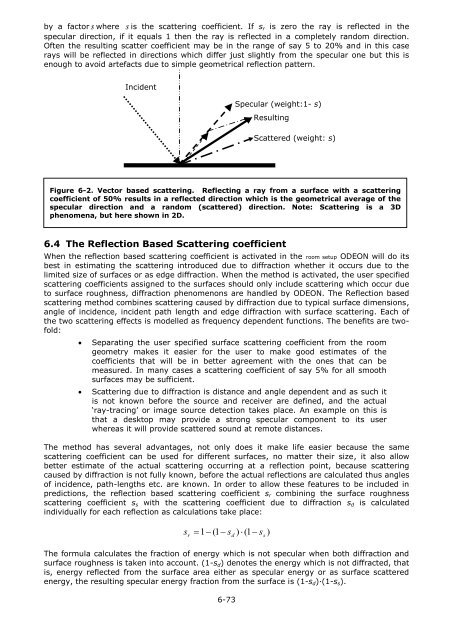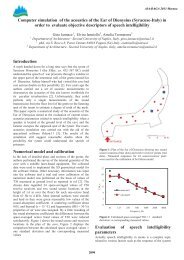Download - Odeon
Download - Odeon
Download - Odeon
You also want an ePaper? Increase the reach of your titles
YUMPU automatically turns print PDFs into web optimized ePapers that Google loves.
y a factor s where s is the scattering coefficient. If s r is zero the ray is reflected in the<br />
specular direction, if it equals 1 then the ray is reflected in a completely random direction.<br />
Often the resulting scatter coefficient may be in the range of say 5 to 20% and in this case<br />
rays will be reflected in directions which differ just slightly from the specular one but this is<br />
enough to avoid artefacts due to simple geometrical reflection pattern.<br />
Incident<br />
Specular (weight:1- s)<br />
Resulting<br />
Scattered (weight: s)<br />
Figure 6-2. Vector based scattering. Reflecting a ray from a surface with a scattering<br />
coefficient of 50% results in a reflected direction which is the geometrical average of the<br />
specular direction and a random (scattered) direction. Note: Scattering is a 3D<br />
phenomena, but here shown in 2D.<br />
6.4 The Reflection Based Scattering coefficient<br />
When the reflection based scattering coefficient is activated in the room setup ODEON will do its<br />
best in estimating the scattering introduced due to diffraction whether it occurs due to the<br />
limited size of surfaces or as edge diffraction. When the method is activated, the user specified<br />
scattering coefficients assigned to the surfaces should only include scattering which occur due<br />
to surface roughness, diffraction phenomenons are handled by ODEON. The Reflection based<br />
scattering method combines scattering caused by diffraction due to typical surface dimensions,<br />
angle of incidence, incident path length and edge diffraction with surface scattering. Each of<br />
the two scattering effects is modelled as frequency dependent functions. The benefits are twofold:<br />
<br />
<br />
Separating the user specified surface scattering coefficient from the room<br />
geometry makes it easier for the user to make good estimates of the<br />
coefficients that will be in better agreement with the ones that can be<br />
measured. In many cases a scattering coefficient of say 5% for all smooth<br />
surfaces may be sufficient.<br />
Scattering due to diffraction is distance and angle dependent and as such it<br />
is not known before the source and receiver are defined, and the actual<br />
‘ray-tracing’ or image source detection takes place. An example on this is<br />
that a desktop may provide a strong specular component to its user<br />
whereas it will provide scattered sound at remote distances.<br />
The method has several advantages, not only does it make life easier because the same<br />
scattering coefficient can be used for different surfaces, no matter their size, it also allow<br />
better estimate of the actual scattering occurring at a reflection point, because scattering<br />
caused by diffraction is not fully known, before the actual reflections are calculated thus angles<br />
of incidence, path-lengths etc. are known. In order to allow these features to be included in<br />
predictions, the reflection based scattering coefficient s r combining the surface roughness<br />
scattering coefficient s s with the scattering coefficient due to diffraction s d is calculated<br />
individually for each reflection as calculations take place:<br />
s<br />
r<br />
1<br />
(1 sd<br />
) (1<br />
ss<br />
)<br />
The formula calculates the fraction of energy which is not specular when both diffraction and<br />
surface roughness is taken into account. (1-s d ) denotes the energy which is not diffracted, that<br />
is, energy reflected from the surface area either as specular energy or as surface scattered<br />
energy, the resulting specular energy fraction from the surface is (1-s d )∙(1-s s ).<br />
6-73

















